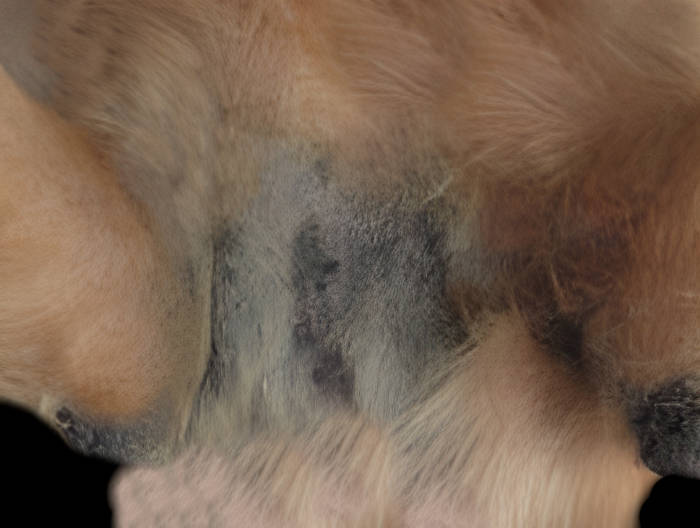
This article was updated on June 10th, 2023
In my veterinary hospital, I have many owners bring in their dogs because they have developed thick, abnormally appearing skin on their ears, belly, or legs (“Elephant skin”). These dogs are typically itchy and uncomfortable. This condition occurs when dogs have an overgrowth of yeast on their skin and the result can be what many owners refer to as “elephant skin,” medically known as pachydermatitis.
What’s elephant skin in dogs?
Also known as yeast dermatitis, the skin appears very thick, rough, dark, and irritated due to inflammation secondary to the yeast overgrowth. The most common yeast found on dogs with pachydermatitis is Malassezia pachydermatitis. This is an extremely common cause of skin inflammation in dogs and often occurs secondary to allergies.
Though this yeast is a normal inhabitant of skin, its abnormal overgrowth can be an itchy problem.
Pictures of elephant skin in dogs:




The condition can become chronic if left untreated
Dogs with elephant skin need to be seen by a veterinarian. Left untreated, the condition can become chronic, and the skin may be damaged.
Over-The-Counter antifungal shampoos can be effective but only with mild cases
Very mild cases may respond to over-the-counter antifungal shampoos, such as Head and Shoulders™, or the Dechra Mal-A-Ket Antibacterial and Antifungal Pet Shampoos.
However, keep i mind that if the underlying cause is not found and addressed, the issue is likely to recur. You should also never give your dog any prescription or OTC medications without the express direction to do so by your vet.
Keep in mind that these skin conditions are miserable for your dog and veterinary treatment will be more effective if started early. Do not delay veterinary care.
Signs that you need to see your vet
If you notice that your dog has thick, red, irritated, or discolored skin, they are licking or scratching more than normal, or they have a musty odor, you should make them an appointment to see their doctor.
How will the vet diagnose?
Often, we may have a pretty good idea that a dog is suffering from yeast pachydermatitis, or “elephant skin,” just by the physical exam findings and history. The skin has a distinctive appearance (see pictures above) and also most often has a musty, foul odor. However, further diagnostics may be indicated to get to the root cause. Skin scrapings, tape preps, and biopsies may need to be performed to identify the organism causing the issue. If underlying allergies are suspected, they will need to be addressed as well, to prevent recurrence.
For initial diagnostics, owners can expect to pay between $100-$500, depending on what procedures are performed.
Veterinary treatments for elephant skin in dogs
Which treatment is right for your dog will depend on many factors, including severity, underlying cause, and response to therapy.
Topical treatment – Yeast pachydermatitis, or “elephant skin,” tends to respond best when treated with both topical and systemic approaches. Medicated shampoos, sprays, and topical ointments may all be prescribed.Owners should follow the directions provided by their veterinarian for optimum results.
Oral treatment- In addition to topical treatment, many dogs will require oral treatments as well. This typically involves oral antifungal medications to address the yeast overgrowth, as well as oral antibiotics if there is a secondary bacterial infection present on the skin.
Pachydermatitis can be somewhat resistant to treatment and affected dogs may need to be treated for long periods of time to effectively clear the issue. This could mean weeks to months of therapy. Antifungal medications can have unwanted side effects involving the dog’s liver, so your veterinarian will monitor with periodic blood work.
Underlying chronic conditions that are contributing to the overgrowth of yeast, such as food and environmental allergies, will need to be addressed as well. Allergies are not curable, but must be managed throughout a dog’s life.
Treatment Costs
The cost to treat a case of yeast dermatitis, or “elephant skin,” varies greatly depending on the size of the dog, the severity of the condition, and the presence of any underlying issue. Oral antifungal medications can be fairly pricey, and the larger the dog, the more medication will be needed. For an initial course of therapy, for an average sized dog, an owner can anticipate spending $100-$300 on topical and oral medications. Allergy management medications and prescription foods will add to this total.
Recovery and timeline for recovery
As mentioned above, pachydermatitis often requires long-term therapy. It is common to treat with both topical and oral medications for 6-12 weeks initially. Luckily, with proper treatment and the control of any underlying conditions, such as allergies, the prognosis is excellent for most dogs.
Disclaimer: This website's content is not a substitute for veterinary care. Always consult with your veterinarian for healthcare decisions. Read More.


Be the first to comment